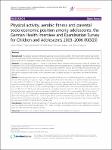Physical activity, aerobic fitness and parental socio-economic position among adolescents: the German Health Interview and Examination Survey for Children and Adolescents 2003–2006 (KiGGS)
Finger, Jonas
Mensink, Gert
Banzer, Winfried
Lampert, Thomas
Tylleskär, Thorkild
Background: The positive association between parental socio-economic position (PSEP) and health among adolescents may be partly explained by physical activity behaviour. We investigated the associations between physical activity, aerobic fitness and PSEP in a population based sample of German adolescents. Methods: 5,251 participants, aged 11–17 years, in the German Health Interview and Examination Survey for Children and Adolescents 2003–2006 (KiGGS) underwent a sub-maximal cycle ergometer test and completed a questionnaire obtaining information on physical activity and media use. The associations between physical activity, media use, aerobic fitness and PSEP were analysed with multivariate logistic regression models for boys and girls separately. Odds ratios (ORs) of PSEP (education, occupation and income) on the outcomes were calculated adjusted for age, region, and other influencing factors. Results: Parental education was more strongly associated with the outcome variables than parental occupation and income. After adjusting for age and region, a higher parental education level was associated with better aerobic fitness – with an OR of 1.5 (95% CI 1.2-1.9) for girls whose parents had secondary education and 1.9 (1.4-2.5) for girls whose parents had tertiary education compared to girls whose parents had primary education. The corresponding ORs for boys were 1.3 (1.0-1.6) and 1.6 (1.2-2.1), respectively. Higher parental education level was associated with lower media use: an OR of 2.1 (1.5-3.0) for girls whose parents had secondary education and 2.7 (1.8-4.1) for girls whose parents had primary education compared to girls whose parents had tertiary education. The corresponding ORs for boys were 1.5 (1.2-1.9) and 1.9 (1.5-2.5), respectively. Higher parental education level was associated with a higher physical activity level only among girls: an OR of 1.3 (1.0-1.6) for girls whose parents had secondary education and 1.2 (0.9-1.5) for girls whose parents had tertiary education compared to girls whose parents had primary education. The corresponding ORs for boys were 0.9 (0.8-1.2) and 0.8 (0.6-1.0), respectively. Conclusions: Adolescents of parents with low SEP showed a lower level of aerobic fitness and higher levels of media use than adolescents of parents with higher SEP. Health-promotion interventions need to reach adolescents of parents with low PSEP and stimulate physical activity.
Dateien zu dieser Publikation
Keine Lizenzangabe

